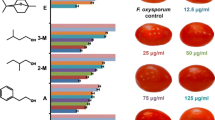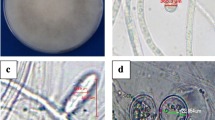Abstract
A bioassay system was developed to test the effects of volatile compounds on the growth of hyphae from germinating fungal spores. Volatiles from crushed tomato leaves inhibited hyphal growth of two fungal pathogens,Alternaria alternata andBotrytis cinerea. Aldehydes, including C6 and C9 compounds formed by the lipoxygenase enzyme pathway upon wounding leaves, inhibited growth of both fungal species. Terpene hydrocarbons, 2-carene and limonene, had no significant effect on hyphal growth. The quantities of volatile compounds in the vapor phase of the bioassay system were measured by direct headspace sampling and GC analysis.
Similar content being viewed by others
References
Bradow, J.M., andConnick, W.J., Jr 1990. Volatile seed germination inhibitors from plant residues.J. Chem. Ecol. 16:645–666.
Buttery, R.G., Ling, L.C., andLight, D.M. 1987. Tomato leaf volatile aroma components.J. Agr. Food Chem. 35:1039–1042.
French, R.C. 1990. Stimulation of germination of teliospores ofPuccinia punctiformis by nonyl, decyl, and dodecyl isothiocyanates and related volatile compounds.J. Agr. Food Chem. 38:1604–1607.
French, R.C., andGallimore, M.D. 1971. Effect of some nonyl derivatives and related compounds on germination of uredospores.J. Agr. Food Chem. 19:912–915.
French, R.C., Graham, C.L., Gale, A.W., andLong, R.K. 1977. Structural and exposure time requirements for chemical stimulation of germination of uredospores ofUromyces phaseoli.J. Agr. Food Chem. 25:84–88.
Galliard, T., andChan, H.W.-S. 1980. Lipoxygenases, pp. 131–161,in P.K. Stumpf (ed.). The Biochemistry of Plants, Vol. 4. Academic Press, New York.
Gardner, H.W., Dorbos, D.L., Jr., andDesjardins, A.E. 1990. Hexanal,trans-2-hexenal, andtrans-2-nonenal inhibit soybean,Glycine max seed germination.J. Agr. Food Chem. 38:1316–1320.
Hamilton-Kemp, T.R., Andersen, R.A., Hildebrand, D.F., Loughrin, J.H., andFleming, P.D. 1987. Effects of lipoxygenase inhibitors on the formation of volatile compounds in wheat.Phytochemistry 26:1273–1277.
Hamilton-Kemp, T.R., Loughrin, J.H., Archbold, D.D., Andersen, R.A., andHildebrand, D.F. 1991. Inhibition of pollen germination by volatile compounds including 2-hexenal and 3-hexenal.J. Agr. Food Chem. 39:952–956.
Hatanaka, A., Kajiwara, T., andSekiya, J. 1987. Biosynthetic pathway for C6 aldehydes formation from linolenic acid in green leaves.Chem. Phys. Lipids 44:341–361.
Kaneko, S., Okitani, A., Hayase, F., andKato, H. 1989. Novel cross-linking compounds formed through the reaction of N2-acetyltryptophan with hexanal.Agr. Biol. Chem. 53:2679–2685.
Major, R.T., Marchini, P., andSproston, T. 1960. Isolation fromGinkgo biloba of an inhibitor of fungus growth.J. Biol. Chem. 235:3298–3299.
Nyvall, R.F.1979. Field Crop Diseases Handbook. AVI, Westport, CT.
Phillips, D.R., Matthew, J.A., Reynolds, J., andFenwick, G.R. 1979. Partial purification and properties of a cis-3:trans-2-enal isomerase from cucumber fruit.Phytochemistry 18:401–404.
Schauenstein, E., Esterbauer, H., andZollner, H. 1977. Aldehydes in Biological Systems: Their Natural Occurrence and Biological Activities. Pion, London.
Schildknecht, H., andRauch, G. 1961. Report on the defensive substances of plants II. The chemical nature of volatile phytocides of leafy plants, particularlyRobinia pseudacacia.Z. Naturforsch. 16b:422–429.
Sodum, R.S., andChang, F.L. 1989. Structural characterization of adducts formed in the reaction of 2,3-epoxy-4-hydroxynonanal with deoxyguanosine.Chem. Res. Toxicol 2:23–28.
Spurr, H.W., Jr. 1973. An efficient method for producing and studying tobacco brown-spot disease in the laboratory.Tobacco Sci. XVII:145–148.
Urbasch, I. 1984. Production of C6-wound gases by plants and the effect on some phytopathogenic fungi.Z. Naturforsch. 39c:1003–1007.
Urbasch, I. 1987. Transformations oftrans-2-hexenal byBortrytis cinerea PERS. as detoxification mechanisms.Z. Naturforsch. 42c:64–68.
Wilson, C.L., Franklin, J.D., andOtto, B.E. 1987. Fruit volatiles inhibitory toMonilinia fructicola andBotrytis cinerea.Plant Dis. 71:316–319.
Winberry, W.T., Jr., Murphy, N.T., andRiggin, R.M. 1988. Method for the Determination of Volatile Compounds in Ambient Air Using Tenax Adsorption and Gas Chromatography/Mass Spectrometry (GC/MS). EPA/600/4-89/017. U.S. Environmental Protection Agency, Research Triangle Park, NC.
Zeringue, H.J., Jr., andMcCormick, S.P. 1989. Relationships between cotton leaf-derived volatiles and growth ofAspergillus flavus.J. Am. Oil Chem. Soc. 66:581–585.
Author information
Authors and Affiliations
Rights and permissions
About this article
Cite this article
Hamilton-Kemp, T.R., McCracken, C.T., Loughrin, J.H. et al. Effects of some natural volatile compounds on the pathogenic fungiAlternaria alternata andBotrytis cinerea . J Chem Ecol 18, 1083–1091 (1992). https://doi.org/10.1007/BF00980064
Received:
Accepted:
Issue Date:
DOI: https://doi.org/10.1007/BF00980064




